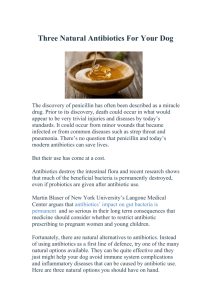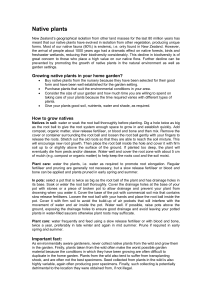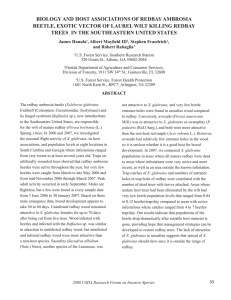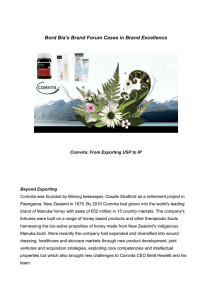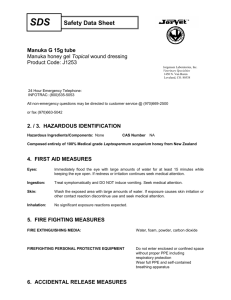Xyleborus glabratus (Coleoptera: Scolytinae), the Vector of Laurel Wilt
advertisement
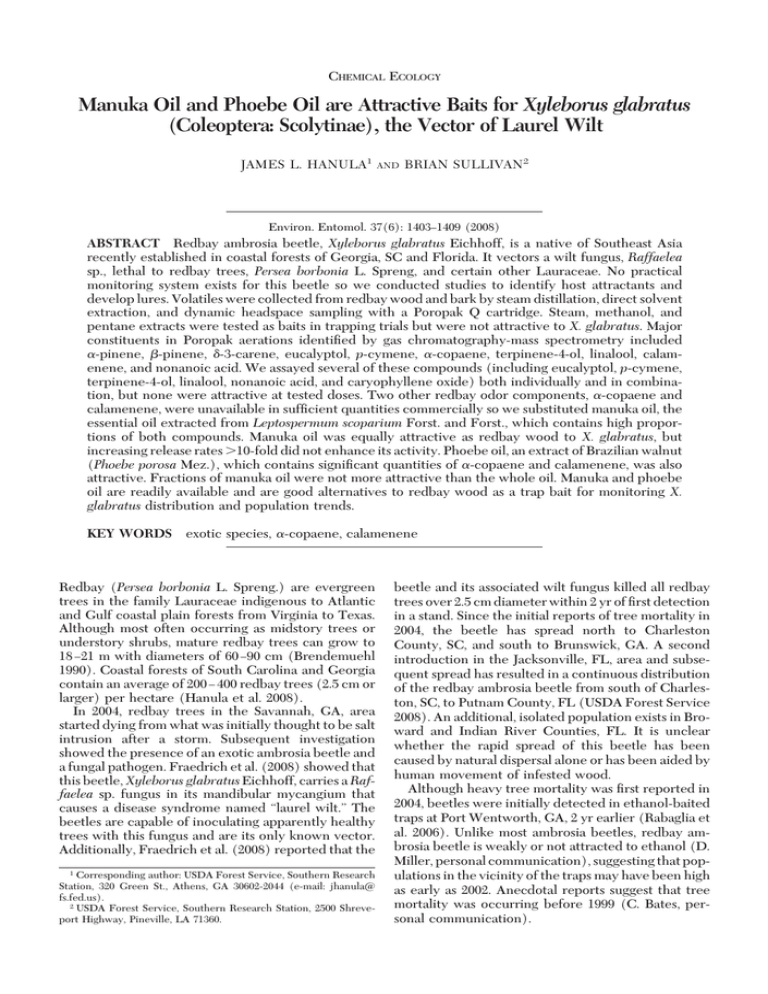
CHEMICAL ECOLOGY Manuka Oil and Phoebe Oil are Attractive Baits for Xyleborus glabratus (Coleoptera: Scolytinae), the Vector of Laurel Wilt JAMES L. HANULA1 AND BRIAN SULLIVAN2 Environ. Entomol. 37(6): 1403Ð1409 (2008) ABSTRACT Redbay ambrosia beetle, Xyleborus glabratus Eichhoff, is a native of Southeast Asia recently established in coastal forests of Georgia, SC and Florida. It vectors a wilt fungus, Raffaelea sp., lethal to redbay trees, Persea borbonia L. Spreng, and certain other Lauraceae. No practical monitoring system exists for this beetle so we conducted studies to identify host attractants and develop lures. Volatiles were collected from redbay wood and bark by steam distillation, direct solvent extraction, and dynamic headspace sampling with a Poropak Q cartridge. Steam, methanol, and pentane extracts were tested as baits in trapping trials but were not attractive to X. glabratus. Major constituents in Poropak aerations identiÞed by gas chromatography-mass spectrometry included ␣-pinene, -pinene, ␦-3-carene, eucalyptol, p-cymene, ␣-copaene, terpinene-4-ol, linalool, calamenene, and nonanoic acid. We assayed several of these compounds (including eucalyptol, p-cymene, terpinene-4-ol, linalool, nonanoic acid, and caryophyllene oxide) both individually and in combination, but none were attractive at tested doses. Two other redbay odor components, ␣-copaene and calamenene, were unavailable in sufÞcient quantities commercially so we substituted manuka oil, the essential oil extracted from Leptospermum scoparium Forst. and Forst., which contains high proportions of both compounds. Manuka oil was equally attractive as redbay wood to X. glabratus, but increasing release rates ⬎10-fold did not enhance its activity. Phoebe oil, an extract of Brazilian walnut (Phoebe porosa Mez.), which contains signiÞcant quantities of ␣-copaene and calamenene, was also attractive. Fractions of manuka oil were not more attractive than the whole oil. Manuka and phoebe oil are readily available and are good alternatives to redbay wood as a trap bait for monitoring X. glabratus distribution and population trends. KEY WORDS exotic species, ␣-copaene, calamenene Redbay (Persea borbonia L. Spreng.) are evergreen trees in the family Lauraceae indigenous to Atlantic and Gulf coastal plain forests from Virginia to Texas. Although most often occurring as midstory trees or understory shrubs, mature redbay trees can grow to 18 Ð21 m with diameters of 60 Ð90 cm (Brendemuehl 1990). Coastal forests of South Carolina and Georgia contain an average of 200 Ð 400 redbay trees (2.5 cm or larger) per hectare (Hanula et al. 2008). In 2004, redbay trees in the Savannah, GA, area started dying from what was initially thought to be salt intrusion after a storm. Subsequent investigation showed the presence of an exotic ambrosia beetle and a fungal pathogen. Fraedrich et al. (2008) showed that this beetle, Xyleborus glabratus Eichhoff, carries a Raffaelea sp. fungus in its mandibular mycangium that causes a disease syndrome named “laurel wilt.” The beetles are capable of inoculating apparently healthy trees with this fungus and are its only known vector. Additionally, Fraedrich et al. (2008) reported that the 1 Corresponding author: USDA Forest Service, Southern Research Station, 320 Green St., Athens, GA 30602-2044 (e-mail: jhanula@ fs.fed.us). 2 USDA Forest Service, Southern Research Station, 2500 Shreveport Highway, Pineville, LA 71360. beetle and its associated wilt fungus killed all redbay trees over 2.5 cm diameter within 2 yr of Þrst detection in a stand. Since the initial reports of tree mortality in 2004, the beetle has spread north to Charleston County, SC, and south to Brunswick, GA. A second introduction in the Jacksonville, FL, area and subsequent spread has resulted in a continuous distribution of the redbay ambrosia beetle from south of Charleston, SC, to Putnam County, FL (USDA Forest Service 2008). An additional, isolated population exists in Broward and Indian River Counties, FL. It is unclear whether the rapid spread of this beetle has been caused by natural dispersal alone or has been aided by human movement of infested wood. Although heavy tree mortality was Þrst reported in 2004, beetles were initially detected in ethanol-baited traps at Port Wentworth, GA, 2 yr earlier (Rabaglia et al. 2006). Unlike most ambrosia beetles, redbay ambrosia beetle is weakly or not attracted to ethanol (D. Miller, personal communication), suggesting that populations in the vicinity of the traps may have been high as early as 2002. Anecdotal reports suggest that tree mortality was occurring before 1999 (C. Bates, personal communication). 1404 ENVIRONMENTAL ENTOMOLOGY Given its already widespread establishment, eradication of X. glabratus is not feasible. Furthermore, conventional suppression efforts based on sanitation cutting are unlikely to succeed because of the speed of range expansion by this species, the rapid tree mortality in infested areas, the ability of a single beetle to inoculate and kill a tree, and the high density of suitable hosts. Now that the virulence of this pest is known, detection of X. glabratus at ports of entry should be a priority. However, the poor performance of standard ethanol-baited ambrosia beetle traps (D. R. Miller, personal communication) suggests that better attractants are needed for detecting and delimiting populations. Wounded or cut redbay are attractive to X. glabratus, but presence of the fungal symbiont or beetles themselves in the wood did not contribute to attraction (Hanula et al. 2008). Currently, cut sections from healthy or diseased redbay trees are the best baits available for trapping this insect (Hanula et al. 2008). We report here a series of experiments to identify and evaluate attractants for the redbay ambrosia beetle. Materials and Methods Field studies were conducted during September and October 2006 and from June to October 2007 at Hunting Island State Park (Beaufort County, SC) located on a small barrier island in the southeastern corner of the state. The forest, located between the dunes and coastal marsh, consisted of a dominant overstory of loblolly pine (Pinus taeda L.); a midstory of redbay, live oak (Quercus viginiana Nutt.); cabbage palm trees [Sabal palmetto (Walt.) Lodd. ex J.A. and J.H. Schultes]; a shrub layer of waxmyrtle (Morella cerifera L. Small) and redbay; and an understory dominated by cabbage palm seedlings. In August 2007, the island had an average of 44 (SE ⫽ 6.3) live redbay trees/ha 2.5 cm diameter or larger and 216 (SE ⫽ 23.3) dead trees/ha in the same size range that were recently killed, i.e., they still had some dead leaves attached (Hanula et al. 2008). Collection of Redbay Volatiles. A Clevenger apparatus was used to extract lighter-than-water essential oils from redbay tissue. Freshly cut redbay wood with bark was chipped in an 8-horsepower chipper/vac (Troy-Bilt, Jefferson, WI). Sections of wood too large to Þt in the chipper were split before chipping. We placed 500 g of fresh chips in a 2-liter Erlenmeyer ßask with 1 liter of distilled water and attached the ßask to the Clevenger apparatus after the water began to boil. Only a few microliters of oil were collected during extensive boiling of the wood chips (⬃6 h), so we also collected the distilled water fraction from the Clevenger apparatus. This fraction, which had a strong odor and was available in sufÞcient quantities, was assayed for its attractiveness to X. glabratus instead of the oil. We also extracted 500 g of fresh wood chips with 500 ml of either methanol or pentane. The wood chips were steeped in the solvent for 1 h at room temperature, Þltered, and concentrated to 50 ml in a rotary evaporator. Vol. 37, no. 6 Behavioral Bioassays. Responses of X. glabratus to candidate attractive substances were assayed in trapping trials. Each trial was replicated four times. Trial 1 used ßight-intercept traps that consisted of a single panel (20 by 30 cm) of clear Plexiglas centered above a white, 2-liter capacity plastic bucket partially Þlled with low-toxicity antifreeze (propylene glycol). These traps were hung ⬇2 m above the ground on ropes tied between two nonhost trees with bait vials suspended near the middle of the panel. Because it was unknown whether bole-like visual stimuli were necessary for beetles to orient to an odor source, we provided a dark silhouette by hanging a sleeve of black cloth (12 cm wide and 40 cm long) against one side of the Plexiglas barrier, opposite the baits. For trials 2Ð 6, we used sticky traps rather than panel traps because of their similar effectiveness and cost but greater convenience. Sticky traps were constructed from solitary, white, wing-style trap bottoms (23 by 28 cm; Scentry Biologicals, Billings, MT) secured ßat with binder clips against a Plexiglas panel (20 by 30 cm). A single trap consisted of two such panels suspended sticky-sideout at 2 m height from opposite sides of a wooden stake. A large binder clip secured both panels to the stake and prevented movement by the wind. Bait vials were suspended near the center of one of the panels. For all trials, traps were ⬇10 m apart within complete blocks, and blocks were separated by ⬎50 m. Traps were at least 5 m from the nearest host tree. Two blocks were located on both the north and south ends of the island. Trapping Trial 1. Attractiveness of Clevenger, methanol, and pentane extracts of redbay tissue were compared with a methanol blank which was used as a control because alcohols are attractive to some ambrosia beetles. Baits consisted of a piece of cotton dental wick (1 cm diameter; 4 cm long) inside a 25-ml capacity glass scintillation vial Þlled with 5 ml of the test substance. A single 3-mm-diameter hole was drilled through the vial cap to allow volatiles to escape. Beetles responding to the baits were collected semiweekly from 21 September to 15 October 2006. Trapping Trial 2. We compared attractiveness of a methanol-only control to seven compounds (Table 1) identiÞed in volatile aerations of redbay tissue (see below), presented either singly or in combination. We also tested manuka oil (Coast Biologicals, Bombay, South Aukland, New Zealand), an essential oil extracted from wild manuka (Leptospermum scoparium Forst. and Forst.) plants, because it contained relatively large quantities of two major volatiles (Porter and Wilkins 1999), copaene and calamenene, that we had identiÞed in redbay but were not readily available commercially. Liquid test compounds and the manuka oil were absorbed (100 l) onto one half of a cotton dental wick (1 cm diameter; 2 cm long) placed inside an uncapped 25-ml capacity scintillation vial. Caryophyllene oxide (solid at room temperature) was dissolved in methanol (50 mg/ml) and 100 l was applied (i.e., 5 mg caryophyllene oxide) to the wick. Catch was collected weekly from 17 to 31 July 2007. December 2008 Table 1. HANULA AND SULLIVAN: MANUKA OIL ATTRACTS Xyleborus glabratus 1405 Compounds identified in aeration of chipped bark and sapwood of redbay No.a Retention time (min) Compound name CAS no. Compound class 1 2 3 4 5 6 7 8 9 10 11 12 13 14 15 16 6.65 7.84 8.41 9.40 10.40 13.67 14.36 14.89 16.11 17.61 18.23 18.31 18.75 20.02 22.45 24.44 ␣-Pinene -Pinene ␦-3-Carene Eucalyptol p-Cymene ␣-Cubebene ␣ -Copaene Linalool Terpinen-4-ol ␣-Terpineol ␣-Muuroleneb  -Selineneb ␦-Cadineneb Calamenenec Caryophyllene oxide Nonanoic acid 80-56-8 127-91-3 13466-78-9 470-82-6 99-87-6 17699-14-8 3856-25-5 78-70-6 562-74-3 98-55-5 31983-22-9 17066-67-0 483-76-1 483-77-2 1139-30-6 112-05-0 Monoterpene hydrocarbon Monoterpene hydrocarbon Monoterpene hydrocarbon Monoterpene ether Monoterpene hydrocarbon Sesquiterpene hydrocarbon Sesquiterpene hydrocarbon Monoterpene alcohol Monoterpene alcohol Monoterpene alcohol Sesquiterpene hydrocarbon Sesquiterpene hydrocarbon Sesquiterpene hydrocarbon Sesquiterpene hydrocarbon Sesquiterpene ketone n-Hydrocarbon acid a b c Peak no. of Fig. 1. IdentiÞcation by mass spectral match only. IdentiÞcation by mass spectral match and retention time match with compound in previously characterized plant essential oil (see text). Trapping Trial 3. The most promising candidate lures from trial 2 were assayed at higher release rates. Clevenger extract of redbay (1 ml), manuka oil (300 l), eucalyptol (300 l), caryophyllene oxide (300 l as 50 mg/ml methanol), and methanol (300 l) were each applied to half of a cotton dental wick pinned directly to the center of one sticky panel of each trap. Traps were run from 31 July to 7 August 2007. Trapping Trial 4. We compared attractiveness of manuka oil at three different release rates to freshly cut sections (12 cm diameter; 40 cm long) from a healthy redbay tree and unbaited control traps. The redbay sections were hung vertically at 2 m height from ropes tied between two nonhost trees and had two sticky panels suspended on opposite sides. Manuka oil releasers consisted of a 4-ml glass vial with a 5-mm-diameter hole in the cap through which a cotton wick (5 mm diameter, cut from a cotton deck mop; Libman, Arcola, IL) extended either 0.5, 2, or 4 cm. The wick was threaded through a cone cut from the tip of a transfer pipette that prevented the wick from slipping down into the vial. Each vial contained ⬇6 Ð7 g of manuka oil. Release rates were determined gravimetrically while the releasers were outdoors on a shaded porch in Athens, GA from 20 to 22 August. The experiment was conducted 14 Ð21 August 2007. Trapping Trial 5. Release rates of wick baits used in trial four were highly variable and not proportional to wick length. The problem was corrected by changing the dimensions of the cone supporting the wick. Releasers were tested outdoors as before from 24 to 30 August. The same treatments as trial 4 were retested using the modiÞed releasers on 21 August to 9 October 2007. Additionally, we tested a commercially developed releaser for manuka oil (Synergy Semiochemicals, Burnaby, Canada; labeled release rate, 50 mg/d). The experiment was conducted 27 August to 9 October, 2007. Trapping Trial 6: Fractions of Manuka Oil and Phoebe Oil. We assayed two distilled manuka oil fractions supplied by the manufacturer (Coast Biologicals), a fraction enriched in the relatively more volatile constituents of manuka oil (fraction 7), and the reciprocal fraction enriched in the relatively less volatile constituents (low-odor fraction), with phoebe oil, (Aripê Citrus Agro Industrial, Montenegro, Brazil), an extract of Brazilian walnut, Phoebe porosa Mez. (Lauraceae), containing relatively high amounts of ␣-copaene (Weyerstahl et al. 1994). We compared beetle responses to traps baited with one of these three substances released from vials with 2-cm-long wicks, redbay bolts, or empty vials from 21 August to 9 October 2007. Chemical Analyses of Redbay Volatiles and Essential Oil Baits. Volatiles were collected from redbay wood and bark onto a PTFE-encased Poropak Q cartridge (0.1 g, 50 Ð 80 mesh; Millipore, Bedford, MA). The cartridge was attached to the outlet of a 50-ml capacity glass cold-Þnger tube containing redbay chips (8 g; as described previously), and the inlet was attached to a charcoal Þlter. Air (20 ml/min) was drawn through the tube and cartridge for 3 h at room temperature. The cartridge was extracted with 1.2 ml redistilled pentane. The water fraction from the Clevenger extract of redbay (10 ml; used as bait in Þeld trial 1) was extracted sequentially three times with 1 ml redistilled pentane and the extracts combined. Manuka oil, its fractions, and phoebe oil were diluted in hexane (1 l/ml) spiked with 35 g/ml heptyl acetate as an internal standard. Extracts and diluted essential oils were analyzed on an Agilent 6890 Ð5973 coupled gas chromatograph-mass spectral detector (GC-MS) Þtted with an HP-INNOWax (60 m by 0.25 mm by 0.25 m Þlm; Agilent Technologies, Santa Clara, CA) column. The temperature program was 40⬚C for 1 min, 16⬚C/min to 80⬚C, and 7⬚C/min to 230⬚C and held constant for 10 min. Carrier gas (he- 1406 ENVIRONMENTAL ENTOMOLOGY 4 Vol. 37, no. 6 a. Aeration of redbay bark and wood 5 1 8 3 2 7 6 9 10 12 11 13 14 16 15 b. Water condensate from steam extract of redbay bark and wood 4 8 9 10 15 14 ISTD c. Manuka oil 1 7 12 13 6 15 2 4 5 14 ISTD d. “Low odor” manuka oil 12 13 15 7 6 14 e. “Fraction 7” of manuka oil 7 ISTD 6 12 13 1 2 15 5 4 f. Phoebe oil ISTD 7 1 6 2 8 3 5 4 10 6 12 14 16 13 1112 14 18 20 15 22 24 26 Retention Time (min) Fig. 1. Total ion chromatogram (TIC) traces from GC-MS analyses of (a) Porapak QÐcollected volatiles from pieces of chopped redbay bark and wood, (b) water condensate from distillation of redbay bark and wood on a Clevenger still, (c) unaltered manuka oil, (d) a “low-odor” manuka oil fraction, (e) the reciprocal of the low-odor fraction (fraction 7), and (f) phoebe oil. The numerous large peaks eluting after 22 min in the phoebe oil analysis were predominantly oxygenated sesquiterpenes. lium) ßow was Þxed at 1.0 ml/min, and the injector and detector ports were 200 and 240⬚C, respectively. Peaks were identiÞed by mass spectral matches to published spectra and retention time matches to commercially obtained standards. When synthetic standards were not available commercially, retention times of peaks were compared with those of constit- uents of essential oils with previously characterized compositions. Statistical Analyses. All Þeld trials were replicated four times. Each trapping trial was analyzed as a twoway analysis of variance (ANOVA) with treatment and replicate (blocks) as the independent variables and beetle catch as the dependent variable using Proc December 2008 HANULA AND SULLIVAN: MANUKA OIL ATTRACTS Xyleborus glabratus 1407 Fig. 2. Mean (⫾SEM) daily catch of two ambrosia beetle species in traps baited with Clevenger, methanol, or pentane extracts of chipped redbay (P. borbonia) bark and wood at Hunting Island, SC. Within species, columns associated with the same letter were not signiÞcantly different (REGWQ multiple comparison test; n ⫽ 4; P ⬍ 0.05; SAS Institute 1985). GLM (SAS Institute 2000). Means were separated using the Ryan-Einot-Gabriel-Welsch (REGWQ) multiple comparison test (Day and Quinn 1989). Data were transformed using a log transformation when the Shapiro-Wilk test for normality (Proc Univariate; SAS Institute 2000) indicated the data were not normally distributed. Results Extraction and Testing of Redbay Extracts. Major constituents in Poropak aerations of redbay wood and bark (Fig. 1a; Table 1) included ␣-pinene, -pinene, ␦-3-carene, eucalyptol, p-cymene, ␣-copaene, terpinene-4-ol, linalool, calamenene, and nonanoic acid. Loblolly pine resin contains large amounts of both ␣and -pinene. Because we found no evidence X. glabratus were attracted by freshly cut loblolly pine (Pinus taeda L.) wood (Hanula et al. 2008), we did not Table 2. investigate these particular monoterpenes further. In trapping trial 1, Clevenger, methanol, and pentane extracts of redbay wood and bark were not more attractive to X. glabratus than methanol controls (Fig. 2). However, the steam extract was attractive to Xylosandrus crassiusculus (Motschulsky), showing that the release devices were functioning and that the water fraction of Clevenger extract of redbay was attractive to at least one species of xyleborine ambrosia beetle. GC-MS analysis of the Clevenger extract (Fig. 1b) indicated that it contained only oxygenated volatiles identiÞed in the aeration of redbay wood and bark, including eucalyptol, linalool, terpinene-4-ol, and caryophyllene oxide. In trial 2, too few insects were trapped for statistical comparisons, although manuka oil and all chemicals combined caught the most beetles (Table 2). In trial 3, manuka oil was signiÞcantly more attractive to X. glabratus than the other compounds or the water frac- Attraction of X. glabratus to individual constituents of redbay wood volatiles and manuka oil in two trapping trials Attractant Caryophyllene oxide (0.5 g/10 ml methanol) Cineole p-Cymene Linalool Nonanoic acid ␣-Terpinene (⫺)-Terpinen-4-ol Manuka oil ControlÑmethanol All combined Steam extract of redbay Trapping trial 2a Trapping trial 3b Quantity N Total RAB Quantity N Mean RAB/trap (SE) 100 l 100 l 100 l 100 l 100 l 100 l 100 l 100 l 100 l 100 l of each Not tested 4 4 4 4 4 4 4 4 4 4 Ñ 5 6 1 2 1 4 2 9 3 8 Ñ 300 l 300 l Not tested Not tested Not tested Not tested Not tested 300 l 300 l Not tested 1 ml 4 4 4 4 4 4 4 4 4 4 4 1.25 (0.95)bc 1 (0.41)b Ñ Ñ Ñ Ñ Ñ 28.8 (3.52)a 0.8 (0.47)b Ñ 0.5 (0.29)b a Liquid test compounds and the manuka oil were absorbed onto a cotton dental wick placed inside an uncapped 25-ml capacity scintillation vial. b Liquid test compounds and the manuka oil were absorbed onto a cotton dental wick and pinned directly to the trap surface. c Means followed by the same letter were not signiÞcantly different (P ⬍ 0.05; Ryan-Enoit-Gabriel-Welch multiple comparison test). 1408 ENVIRONMENTAL ENTOMOLOGY Vol. 37, no. 6 Table 3. Attraction of X. glabratus (RAB) to either manuka oil eluted from vials with wicks of varying lengths, a commercially produced lure, or freshly cut redbay wood Manuka oil releaser Control 0.5-cm wick 2-cm wick 4-cm wick Commercial Redbay bolt Trapping trial 4 Trapping trial 5 N Release rate mg/d (SE)a RAB/d (SE) 4 4 4 4 Ñ 4 0 32.7 (13.8)ab 25.4 (4.26)a 30.9 (2.67)a Ñ Ñ 0.1 (0.06)a 2.5(0.62)b 2.3 (0.65)b 1.3 (0.21)b Ñ 1.3 (0.53)b N Release rate mg/d (SE)a RAB/d (SE) 4 4 4 4 4 4 0 3.3 (0.74)a 14.6 (2.75)b 17.3 (3.0)b 50 Ñ 0.1 (0.03)a 1.0 (0.15)bc 2.3 (0.85)c 0.7 (0.34)b 1.2 (0.40)bc 2.2 (0.85)c a Release rates were determined outdoors with similar temperatures as occurred during trapping trials. Means within columns followed by the same letter were not signiÞcantly different (P ⬍ 0.05; Ryan-Enoit-Gabriel-Welch multiple comparison test). b tion of the Clevenger extract of redbay (Table 2). Chemical analyses of manuka oil showed relatively large quantities of Þve compounds (␣-pinene, myrcene, calamenene, ␣-cubebene, and copaene; Fig. 1c) it had in common with redbay volatiles. Comparison of Manuka Oil to Redbay. In trapping trial 4, manuka oil releasers were not eluting properly, and all wick lengths had similar release rates ranging from 25 to 33 mg/d (Table 3). The three wick lengths caught signiÞcantly more X. glabratus than unbaited controls, and all three attracted beetles in numbers similar to redbay bolts. In trial 5, we corrected the problem with the manuka oil releasers. The 0.5-cm wicks eluted significantly less manuka oil (3.3 mg/d) than 2- or 4-cm-long wicks (15Ð17 mg/d). All lures with manuka oil caught signiÞcantly more X. glabratus than unbaited controls (Table 3) and, except for the 4-cm-long wicks, the various release devices of manuka oil (including the commercial lure) attracted beetles in numbers similar to those captured in traps baited with fresh redbay wood. Fractions of Manuka Oil and Phoebe Oil. All attractants tested caught signiÞcantly more beetles than unbaited controls (Fig. 3). Phoebe oil, manuka oil, and fraction 7 of manuka oil did not attract beetles in signiÞcantly different numbers than redbay wood. Low odor manuka oil (the reciprocal of fraction 7) attracted signiÞcantly fewer beetles than redbay bolts or phoebe oil but not signiÞcantly fewer than whole manuka oil or fraction 7. The low odor manuka oil contained smaller amounts of higher volatility monoand sesquiterpenes than fraction 7, manuka oil, or phoebe oil (Fig. 1). 2008), although redbay wood is more readily available and is currently used as the operational lure. Aerations of redbay wood contained ␣-pinene, -pinene, ␦-3-carene, eucalyptol, and p-cymene, but these were absent from low-odor manuka oil. Because this oil fraction was similar in attractiveness as whole manuka oil to X. glabratus (Fig. 3), these compounds were presumably unessential components of the X. glabratus attractant. Manuka oil was found to contain relatively large quantities of three sesquiterpene hydrocarbons (calamenene, ␣-cubebene, and ␣-copaene; Fig. 1c; Table 1), which were the only compounds it had in common with redbay extracts other than ␣-pinene and myrcene. In contrast, phoebe oil (Fig. 1f; Table 1), which was similarly attractive to the beetles as manuka oil or redbay wood, contained calamenene and ␣-cubebene in much smaller quantities relative to ␣-copaene. These results suggest ␣-copaene may be the primary attractive component of manuka oil, phoebe oil, and redbay, although other compounds may contribute to attraction as well. Discussion All seven Xyleborus species for which attractants have been identiÞed respond to ethyl alcohol (ElSayed 2007 and references therein). However, D. Miller (personal communication) was unsuccessful in capturing X. glabratus using ethanol lures, so other compounds released from redbay wood presumably serve as host attractants for this species. Redbay ambrosia beetles are attracted to odors from both redbay and avocado, Persea americana Mill. (Hanula et al. Fig. 3. Mean (⫾SEM) daily catch of X. glabratus in traps baited with manuka oil or its fractions, phoebe oil, or a freshly cut redbay bolt. Columns with the same letter were not signiÞcantly different (REGWQ multiple comparison test; n ⫽ 4; P ⬍ 0.05; SAS Institute 1985). December 2008 HANULA AND SULLIVAN: MANUKA OIL ATTRACTS Xyleborus glabratus Crook et al. (2008) pointed out that a variety of other insects, including a number of bark beetles, respond to these sesquiterpenes. However, if ␣-copaene, ␣-cubebene, and/or calamenene are the essential attractive components of redbay wood, the currently limited commercial availability and high price of these compounds in pure form implies that manuka oil or other essential oils may be the most cost-effective sources of artiÞcial X. glabratus attractant. One disadvantage of using essential oils in applications requiring a standardized bait (such as population monitoring) is that the chemical composition may vary among suppliers or batches because of changes in the geographic origin, cultivar, and growing conditions of the extracted plants. This variability has been documented in manuka oil (Porter and Wilkins 1999). Nonetheless, it is likely that essential oilÐ based baits will provide greater consistency in trapping X. glabratus than baits of fresh redbay wood. Recently, Crook et al. (2008) reported manuka oil and phoebe oil were attractive to emerald ash borer, Agrilus planipennis Fairmaire (Coleoptera: Buprestidae), and that six constituents of these oils, including ␣-copaene and ␣-cubebene, stimulated olfactory sensilla of this insect. In addition, they found these compounds were produced by standing ash trees after application of stressors (girdling) capable of stimulating attraction of emerald ash borers. However, logs cut from similar, healthy trees were not as attractive as girdled trees (Poland et al. 2004). ArtiÞcially wounded trees and bolts cut from either healthy or diseased trees are attractive to X. glabratus (Hanula et al. 2008). Our volatiles collections were made from wood and bark of diseased trees; however, Hanula et al. (2008) found no evidence that trees either infected with the laurel wilt fungus or heavily infested with X. glabratus were more attractive to X. glabratus than healthy trees. Manuka and phoebe oil should provide a practical and cost-effective bait alternative to redbay wood in traps used for monitoring X. glabratus distribution and population trends. Additionally, the availability of practical artiÞcial baits for X. glabratus will permit study of attractant-based control strategies for X. glabratus and laurel wilt. X. glabratus populations declined to very low levels in areas where it had killed most of the mature redbay trees (Hanula et al. 2008), hence trap-out or attract-and-kill techniques might be useful for further reducing such suppressed populations giving redbay seedlings, saplings, and stump sprouts an opportunity to develop into mature trees. Such techniques combined with effective sanitation of infested trees could be used to allow redbay populations to recover. In addition, our results in combination with those of Crook et al. (2008) suggest that manuka oil may be an effective attractant for a diversity of hardwood pests and should be considered as bait for early detection of new pest introductions. 1409 Acknowledgments We thank M. Cody, S. Horn, T. Kuntz, and W. Shepherd for technical assistance; D. Crook for helpful suggestions and information on essential oils and baits; B. Courtney for supplying fractions of manuka oil; and L. Weeks at Hunting Island State Park and the South Carolina Department of Parks for providing access to study sites. References Cited Brendemuehl, R. H. 1990. Persea borbonia (L.) Spreng. Redbay, pp. 503Ð510. In R. M. Burns and B. H. Honkala (tech. coor.), Silvics of North America, vol. 2, hardwoods. U.S. Department of Agriculture, Forest Service, Washington, DC. Crook, D. J., A. Khrimian, J. A. Francese, I. Fraser, T. M. Poland, A. J. Sawyer, and V. C. Mastro. 2008. Development of a host based semiochemical lure for trapping emerald ash borer Agrilus planipennis (Coleoptera: Buprestidae). Environ. Entomol. 37: 356 Ð365. Day, R. W., and G. P. Quinn. 1989. Comparison of treatments after an analysis of variance. Ecol. Monogr. 59: 433Ð 463. El-Sayed, A. M. 2007. The pherobase: database of insect pheromones and semiochemicals. (http://www.pherobase.net). Fraedrich, S. W., T. C. Harrington, R. J. Rabaglia, M. D. Ulyshen, A. E. Mayfield III, J. L. Hanula, J. M. Eickwort, and D. R. Miller. 2008. A fungal symbiont of the redbay ambrosia beetle causes a lethal wilt in redbay and other Lauraceae in the southeastern USA. Plant Dis. 92: 215Ð 224. Hanula, J. L., A. E. Mayfield III, S. W. Fraedrich, and R. J. Rabaglia. 2008. Biology and host associations of redbay ambrosia beetle, Xyleborus glabratus Coleoptera: Curculionidae: Scolytinae), exotic vector of laurel wilt killing redbay (Persea borbonia) trees in the Southeastern United States. J. Econ. Entomol. 101: 1276 Ð1296. Poland, T. M., P. DeGroot, G. G. Grant, L. MacDonald, and D. G. McCullough. 2004. Developing attractants and trapping techniques for the emerald ash borer, pp. 15Ð16. In V. C. Mastro and R. Reardon (eds.), Emerald ash borer research and technology development meeting, U.S. Department of Agriculture Forest Health Technology Enterprise Team, Morgantown, WV. Porter, N. G., and A. L. Wilkins. 1999. Chemical, physical and antimicrobial properties of essential oils of Leptospermum scoparium and Kunzea ericoides. Phytochemistry 50: 407Ð15. Rabaglia, R. J., S. A. Dole, and A. I. Cognato. 2006. Review of American Xyleborina (Coleoptera: Curculionidae: Scolytinae) occurring north of Mexico, with an illustrated key. Ann. Entomol. Soc. Am. 99: 1034 Ð1056. SAS Institute. 2000. SAS OnlineDoc?, version 8. SAS Institute, Cary, NC. [USDA] U.S. Department of Agriculture Forest Service. 2008. Laurel wilt. (http://www.fs.fed.us/r8/foresthealth/ laurelwilt/dist_map.shtml). Weyerstahl, P., H. C. Wahlburg, U. Splittgerber, and H. Marshall. 1994. Volatile constituents of Brazilian phoebe oil. Flavour Frag. J. 9: 179Ð186. Received 15 April 2008; accepted 23 June 2008.
